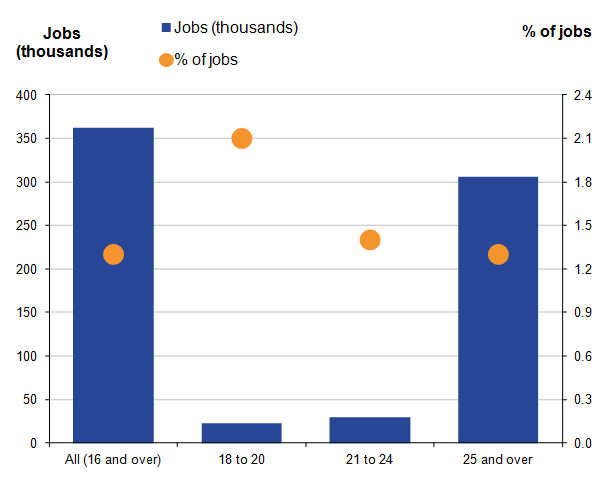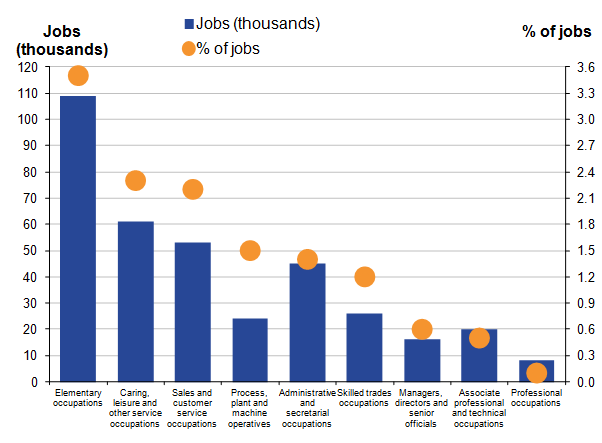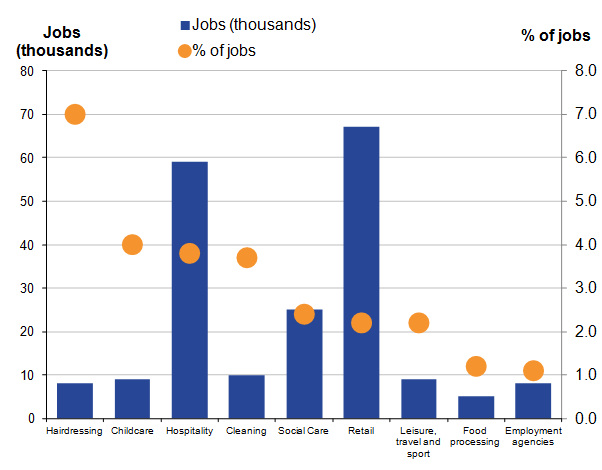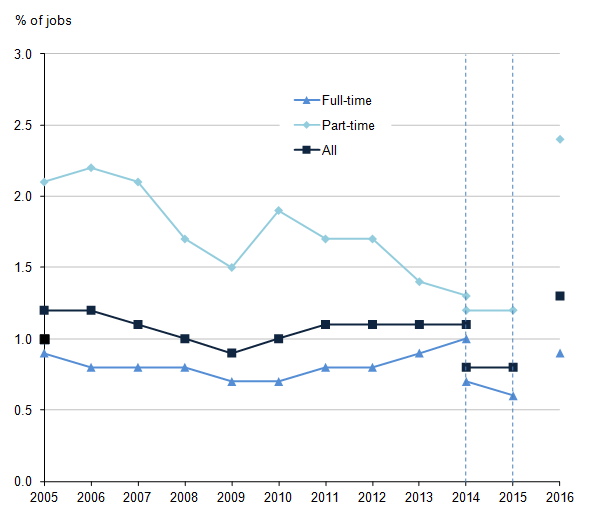1. Main points
There were an estimated 362,000 jobs with pay less than the National Minimum Wage (NMW) or National Living Wage (NLW) held by employees aged 16 and over in April 2016, which constituted 1.3% of UK employee jobs.
There were 178,000 jobs held by full-time employees (0.9% of jobs in this group) with pay less than the minimum wage.
For part-time employees, there were 184,000 jobs (2.4% of jobs in this group) with pay less than the minimum wage.
Nôl i'r tabl cynnwys2. Introduction
This release presents statistics on the number of employee jobs with pay less than the National Minimum Wage (NMW) or new National Living Wage (NLW) in the UK on 13 April 2016. Accompanying datasets showing low pay estimates by sex, working pattern, age, region, occupation and industry are available on our website. The statistics are based on data from the Annual Survey of Hours and Earnings (ASHE). More information on ASHE is also available on our website.
Please note that the estimates in this release cannot be used as a measure of non-compliance with the minimum wage legislation. This is because it is not always possible to determine from the survey data whether an individual is eligible for the minimum wage. For example, if employees receive free accommodation, employers are entitled to offset hourly rates.
The minimum wage is a minimum amount per hour that most workers in the UK are entitled to be paid. There are different rates of minimum wage depending on a worker's age and whether they are an apprentice.
The government’s NLW was introduced on 1 April 2016 for all working people aged 25 and over, and is set at £7.20 per hour. The NMW rates for those under the age of 25 still apply.
On the ASHE reference date in April 2016 the NMW rates (introduced in October 2015) were:
£6.70 for employees aged 21 to 24
£5.30 for employees aged 18 to 20
£3.87 for employees aged 16 to 17
£3.30 for apprentices aged 16 to 18 and those aged 19 or over who are in the first year of their apprenticeship
The increases between October 2014 and October 2015 for these rates were the largest increases in each individual rate since 2010 (prior to 2010 the age groups were different and there were no NMW rates for apprentices).
In previous years the NMW rates for all employees came into force in October, around six months before the ASHE reference date. In 2016 the new NLW rate only came into force a few weeks before the ASHE reference date (13 April). Some employers do not implement the new rates immediately when they come into force, but implement them at a later date. Due to the shorter time between the NLW introduction date and when the ASHE data are collected, they may not have implemented the new rate until after the ASHE reference date. This has resulted in a discontinuity between 2015 and 2016, as the 2016 low pay estimates will include employees whose employers did not implement the new rate until after the ASHE reference date.
It is also known that some employers did not implement the new NLW on 1 April for employees whose pay period began before 1 April. This is because, legally, employers did not need to implement it until the first full pay period following the introduction. Therefore these employees have only been classed as low paid if their hourly earnings were less than the NMW rate that was in place before 1 April.
Nôl i'r tabl cynnwys3. Low pay by age
The proportion of jobs with pay less than the minimum wage varies by age group, reflecting the different rates that apply (as shown in Figure 1). In April 2016 there were 362,000 jobs with pay less than the NMW or NLW held by employees aged 16 and over, which constituted 1.3% of UK employee jobs. For 18- to 20-year-olds, 2.1% of jobs in this age group had pay less than the relevant NMW rate; for employees aged 21 to 24 the proportion was 1.4%; and for employees aged 25 and over, the proportion was 1.3%.
Please note that, due to the small sample size, estimates for the number and proportion of jobs held by 16-to 17-year-olds with pay less than the NMW is considered unreliable for practical purposes and so has not been included in Figure 1.
Figure 1: Number and percentage of jobs paid below the minimum wage by age group
UK, April 2016

Source: Annual Survey of Hours and Earnings (ASHE) - Office for National Statistics
Notes:
Number of jobs paid less than £3.30 per hour (apprentices aged 16 to 18 and those aged 19 or over who are in their first year) or £3.87 per hour (employees aged 16 to 17) or £5.30 per hour (employees aged 18 to 20) or £6.70 per hour (employees aged 21 to 24) or £7.20 per hour (employees aged 25 and over).
Estimates are based on hourly earnings excluding overtime and shift premium payments. Activities of households as employers and extraterritorial organisations as well as employees with an unknown industry status are excluded.
Excludes employees whose pay was affected by absence.
Data are provisional.
Download this image Figure 1: Number and percentage of jobs paid below the minimum wage by age group
.png (6.8 kB) .xls (71.2 kB)4. Low pay among full-time and part-time employees and men and women
Employees in part-time work are more likely than those in full-time work to be paid less than the minimum wage, with 2.4% of part-time jobs and 0.9% of full-time jobs falling below the minimum wage in April 2016 (Figure 2). Jobs held by women are more likely to be paid less than the minimum wage than jobs held by men (1.7% compared with 1.0% in 2016). This is consistent with the fact that a greater proportion of women work part-time than men.
Figure 2: Number and percentage of jobs paid below the minimum wage by full-time, part-time and sex
UK, April 2016

Source: Annual Survey of Hours and Earnings (ASHE) - Office for National Statistics
Notes:
Number of jobs paid at less than £3.30 per hour (apprentices aged 16 to 18 and those aged 19 or over who are in their first year) or £3.87 per hour (employees aged 16 to 17) or £5.30 per hour (employees aged 18 to 20) or £6.70 per hour (employees aged 21 to 24) or £7.20 per hour (employees aged 25 and over).
Estimates are based on hourly earnings excluding overtime and shift premium payments. Activities of households as employers and extraterritorial organisations as well as employees with an unknown industry status are excluded.
Excludes employees whose pay was affected by absence.
Full-time defined as employees working more than 30 paid hours per week (or 25 or more for the teaching professions).
Data are provisional.
Download this image Figure 2: Number and percentage of jobs paid below the minimum wage by full-time, part-time and sex
.png (8.7 kB) .xls (84.5 kB)5. Low pay by region
In April 2016 the British regions with the highest proportion of low-paid jobs were Yorkshire and the Humber and the West Midlands, where 1.7% of jobs were paid below the minimum wage (Figure 3). The next highest were the North West and the East Midlands, both with 1.6% of jobs paid below the minimum wage. The lowest proportion of jobs below the minimum wage was in London (0.9%).
Figure 3: Number and percentage of jobs paid below the minimum wage by work region or country
Great Britain, April 2016

Source: Annual Survey of Hours and Earnings (ASHE) - Office for National Statistics
Notes:
Number of jobs paid at less than £3.30 per hour (apprentices aged 16 to 18 and those aged 19 or over who are in their first year) or £3.87 per hour (employees aged 16 to 17) or £5.30 per hour (employees aged 18 to 20) or £6.70 per hour (employees aged 21 to 24) or £7.20 per hour (employees aged 25 and over).
Estimates are based on hourly earnings excluding overtime and shift premium payments. Activities of households as employers and extraterritorial organisations as well as employees with an unknown industry status are excluded.
Excludes employees whose pay was affected by absence.
Data for Northern Ireland have been excluded for quality reasons.
Data are provisional.
Download this image Figure 3: Number and percentage of jobs paid below the minimum wage by work region or country
.png (9.3 kB) .xls (94.7 kB)6. Low pay by occupation
The occupation group with the highest proportion of low-paid jobs was elementary occupations, in which 3.5% of jobs were paid below the minimum wage in April 2016 (Figure 4). Examples of elementary occupations are bar staff, waiters and waitresses and a range of elementary administrative, service and construction occupations. The lowest proportions were in professional occupations (0.1%) and associate professional and technical occupations (0.5%).
Figure 4: Number and percentage of jobs paid below the minimum wage by major occupational group
UK, April 2016

Source: Annual Survey of Hours and Earnings (ASHE) - Office for National Statistics
Notes:
Number of jobs paid at less than £3.30 per hour (apprentices aged 16 to 18 and those aged 19 or over who are in their first year) or £3.87 per hour (employees aged 16 to 17) or £5.30 per hour (employees aged 18 to 20) or £6.70 per hour (employees aged 21 to 24) or £7.20 (employees aged 25 and over).
Estimates are based on hourly earnings excluding overtime and shift premium payments. Activities of households as employers and extraterritorial organisations as well as employees with an unknown industry status are excluded.
Excludes employees whose pay was affected by absence.
Occupations as defined by the Standard Occupational Classification 2010.
Data are provisional.
Download this image Figure 4: Number and percentage of jobs paid below the minimum wage by major occupational group
.png (17.0 kB) .xls (82.9 kB)7. Low pay by industry
Looking specifically at low-paid industries (as defined by the Low Pay Commission), the hairdressing industry has the highest proportion of low-paid jobs, in which 7.0% of jobs were paid below the minimum wage rate in April 2016 (Figure 6). This is followed by the childcare, hospitality and cleaning industries, in which 4.0%, 3.8% and 3.7% of jobs respectively were paid below the minimum wage rate.
Figure 5: Number and percentage of jobs paid below the minimum wage by low-paid industry groups
UK, April 2016

Source: Annual Survey of Hours and Earnings (ASHE) - Office for National Statistics
Notes:
Number of jobs paid at less than £3.30 per hour (apprentices aged 16 to 18 and those aged 19 or over who are in their first year) or £3.87 per hour (employees aged 16 to 17) or £5.30 per hour (employees aged 18 to 20) or £6.70 per hour (employees aged 21 to 24) or £7.20 (employees aged 25 and over).
Estimates are based on hourly earnings excluding overtime and shift premium payments. Activities of households as employers and extraterritorial organisations as well as employees with an unknown industry status are excluded.
Excludes employees whose pay was affected by absence.
Industries as defined in the Low Pay Commission’s 2014 report (Table A4.1).
Data for agriculture and textiles and clothing have been excluded for quality reasons.
Data are provisional.
Download this image Figure 5: Number and percentage of jobs paid below the minimum wage by low-paid industry groups
.png (8.7 kB) .xls (77.3 kB)8. Trends over time
There have been a number of discontinuities in the low pay series in recent years; consequently, estimates for the number and percentage of jobs paid below the minimum wage over time are not directly comparable.
Before 2014 it was not possible to identify apprentices in the Annual Survey of Hours and Earnings (ASHE) data and thus establish to which NMW rate they were entitled. This meant that all apprentice jobs with pay below the non-apprentice NMW rates were included in the low pay estimate, whether or not their earnings were actually above the apprentice NMW rate. The NLW, introduced on 1 April 2016, has resulted in a discontinuity between 2015 and 2016 due to the shorter time period between its introduction and the ASHE reference date. The 2016 low pay estimates will include employees whose employers did not implement the new rate when it first came into force but implemented it at a later stage after the ASHE reference date. As a result, the 2016 low pay estimates are not directly comparable to those from 2015 and previously.
In April 2016 there were 362,000 employee jobs paid below the minimum wage which constituted 1.3% of UK employee jobs. Between 2005 and 2013 the overall proportion of jobs paid below the NMW had averaged around 1.1% each year. This proportion then reduced slightly to 0.8% following the introduction of the new methodology to account for apprentices in 2014 (Figure 6). The increase in 2016 may be attributed to a few factors, including: the increase for the NMW rates (introduced in October 2015) were the largest increases in each individual rate since 2010; the new NLW for those aged 25 and over was introduced; and, most importantly, there was a shorter time period between the introduction of the NLW rate and when the ASHE data were collected.
Figure 6: Percentage of jobs paid below the National Minimum Wage or National Living Wage for full-time and part-time employees
UK, April 2005 to 2016

Source: Annual Survey of Hours and Earnings (ASHE) - Office for National Statistics
Notes:
Dashed lines indicate a break in the series. A new methodology was introduced in 2014 that takes into account the apprentice minimum wage rate in the calculation of the number of jobs paid below the NMW. Figures before the line are based on the previous methodology and figures after the line are based on the new methodology. Figures for 2014 are provided on both bases.
The new NLW was introduced on 1 April 2016. Figures from 2016 onwards will be based on both the minimum wage combined and are not comparable with previous figures.
See background notes for details of the NMW rates that applied on the ASHE reference date in each year.
Estimates are based on hourly earnings excluding overtime and shift premium payments. Activities of households as employers and extraterritorial organisations as well as employees with an unknown industry status are excluded.
Excludes employees whose pay was affected by absence.
Full-time defined as employees working more than 30 paid hours per week (or 25 or more for the teaching professions).
2016 data are provisional.

